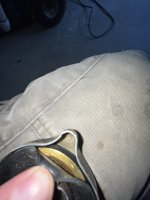Spartans
Seaman
- Joined
- Oct 9, 2016
- Messages
- 56
Hi all. Happy 4th. Here’s a zinger for ya all.
Warning- this is a long drawn out thread so go get a beer and sit down.
Anyhoo, got two older OMC tanks (80’s- single line - btw) that leak from the fuel outlet when the cap is shut tight. Won’t do it when cap is turned to the first stop (where the cap rattles but won’t come off).
I rebuilt the pickup unit on each tank - so that’s new o rings for both pins including the little bushing on the front of the one pin that has the brass seat. Replaced sending unit to tank gasket with NOS gasket. Pins move freely and does not leak at tank connection when I attach a hose and transfer fuel.
I also replaced outer cap gasket and the cap closes tight with resistance- (note if people don’t know there are two rubber gaskets sandwiched between a piece of metal in those caps.
So - if I am wrong here great - I need to be educated but I always thought these tanks are sealed until the connector is attached which allows fuel to flow because the little pins let air to enter into the tank.
My issue is that these two tanks dribble fuel from the outlet with the cap closed tight which leads me to believe it’s sucking air from somewhere.
Now that I have bored you with the background I have two questions:
1. What I am missing? Could it be the sending unit gasket that is leaking? Is it the cap?
2. These tanks are supposed to be sealed until the connector is attached. I am thinking that if it’s getting air in to allow fuel to flow then I should be able reverse the process to apply some amount of positive pressure to the tank and look for leaks - similar to a BBQ. I am thinking of applying 1-2 psi of pressure into the tank and look for leaks with soapy water.
Does anyone see an issue with this approach? I am at my whits end here.
Added phot of cap and sending unit for clarity
Any advice is appreciated. TIA

Warning- this is a long drawn out thread so go get a beer and sit down.
Anyhoo, got two older OMC tanks (80’s- single line - btw) that leak from the fuel outlet when the cap is shut tight. Won’t do it when cap is turned to the first stop (where the cap rattles but won’t come off).
I rebuilt the pickup unit on each tank - so that’s new o rings for both pins including the little bushing on the front of the one pin that has the brass seat. Replaced sending unit to tank gasket with NOS gasket. Pins move freely and does not leak at tank connection when I attach a hose and transfer fuel.
I also replaced outer cap gasket and the cap closes tight with resistance- (note if people don’t know there are two rubber gaskets sandwiched between a piece of metal in those caps.
So - if I am wrong here great - I need to be educated but I always thought these tanks are sealed until the connector is attached which allows fuel to flow because the little pins let air to enter into the tank.
My issue is that these two tanks dribble fuel from the outlet with the cap closed tight which leads me to believe it’s sucking air from somewhere.
Now that I have bored you with the background I have two questions:
1. What I am missing? Could it be the sending unit gasket that is leaking? Is it the cap?
2. These tanks are supposed to be sealed until the connector is attached. I am thinking that if it’s getting air in to allow fuel to flow then I should be able reverse the process to apply some amount of positive pressure to the tank and look for leaks - similar to a BBQ. I am thinking of applying 1-2 psi of pressure into the tank and look for leaks with soapy water.
Does anyone see an issue with this approach? I am at my whits end here.
Added phot of cap and sending unit for clarity
Any advice is appreciated. TIA





















